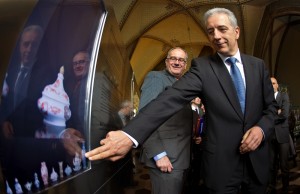An Invitation by Prime Minister Stanislaw Tillich
 Saxony – that’s a small German state with the great habit of changing the future.
Saxony – that’s a small German state with the great habit of changing the future.
Saxony changed the face of the future when in 1989 the Saxon people shook off their Sovietbacked Communist oppressors. This peaceful revolution is a true highlight in the more than thousand years of Saxon history. From Saxony come revolutionary inventions like the European porcelain 300 years ago and the fl attest solar panels of the world today.
And Saxon scientists are going to shape the future way of life in areas like mobility, communication, healthcare, and production. In a nutshell, Saxony is a hidden champion among German high tech regions. About one in ten cars built in Germany comes from Saxony, two times Saxony’s share in the German population. Indeed, Saxony is among the top twenty European innovative regions. The biggest microchip factory of the European continent is a Saxon one. The Saxon semiconductor industry makes Saxony the centre of European micro and nanoelectronics, with a turnover of 5.7 billion € and nearly 52,000 employees.
Global players like Infineon, Globalfoundries and ZMDI have set up business here. Academic and industry researchers develop next-generation products and processes, like organic and printed electronics, fast mobile Internet technology, or smart power grids. The Saxon tradition of shaping the future is certainly going to hold throughout the 21st century.
The results of our innovative spirit are exported to destinations all over the world, with more than a third of industry output being shipped abroad, and a quarter of GDP being generated by exports.
Moreover, Saxony is situated at the heart of Europe, close to the dynamically growing markets of Eastern Europe. Leipzig airport therefore has been chosen by freight carrier DHL as its European hub. Around the airport, a fast-growing logistics industry has sprung up, employing about 80,000 people, including software companies whose products make warehousing and shipment tracking more effi cient.
This innovative spirit goes way back in Saxon history. When silver was found in the 12th century, the ensuing Silver Rush became the start of a high-technology mining and smelting industry – which, in turn, from the late 18th century onwards became the parent of the textile, engineering and automotive industries.
On the other hand, the proceeds of the silver mining made the Saxon princes incredibly rich. They spent some of this wealth on representative buildings and the arts, founding world-famous cultural institutions like the Green Vault museum, the Old Masters Gallery featuring Raphael’s iconic Sistine Madonna, and the Saxon State Orchestra, still admired for its special sound.
This has attracted many an artistic genius to Saxony, like the famous composer Johann Sebastian Bach, who has decisively shaped the repertoire and sound of the Thomanerchor boys’ choir, which celebrates its 800th anniversary this year. However, next to the immigrant top artists were also many home-grown ones like the composer and conductor Richard Wagner. To this day, our vibrant cultural landscape proves a highly inspirational setting for artists and artlovers alike. Among the latter are some of the world’s top scientists like those of the Max Planck Institute of Genetics and Cell Biology at Dresden.
It is one of fifty non-university research institutes that closely work with the four universities and fi ve polytechnics in Saxony. This state-funded research has strong ties with our industry, being the nucleus of a closely-knit public-private innovation system. It generates the innovations that keep the world on the move: batteries, control systems and lightweight construction for e-cars, highly energy-efficient chips for mobile devices, or superconducting trams. A special emphasis is on green production technology and renewable energies that greatly reduce fossil fuel consumption and greenhouse gas emissions. After all, we want to conserve our natural heritage: the beautiful landscape of the Elbe river valley, the bizarre sandstone mountains of the Saxon Switzerland, or the seascapes of the Leipzig and Lausitz regions. They and our cultural highlights draw more than six million visitors per year to Saxony. Moreover, Saxon wines and cuisine make Saxony a pleasant place to live. And when, sadly, one becomes ill in Saxony, excellent healthcare institutions like the university hospitals in Dresden and Leipzig restore you to good health. So when, one day, you will have come to Saxony to stay there or at least leave impressed, Saxony will have shaped your future
